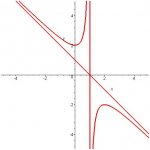SeekerOfDragons
New member
- Joined
- Oct 8, 2009
- Messages
- 46
I'm having some issues in solving the following problem:
Graph the curve y = (-X^2 + 2X - 2) / (X - 1), showing all asymptotes, indicating any symmetries, indicate the intervals over which the graph is increasing, decreasing, concave up, concave down. Identify any relative extrema and points of inflection.
Asymptotes:
there is a vertical asymptote at X = 1. Found by setting (X - 1) = 0 X = 1
I have graphed the function on my calculator and know there is a diagonal down asymptote, but don't know how to calculate it.
To graph, I know you find the min/max by finding y' and solving for X and then plugging X into the original equation to get your points of min/max.
I have calculated y' to be (-X^2 + 2X) / (X - 1)^2
X = 0, X = 2.
Min/Max points are (0, 2) and (0, -2)
To find the points of inflection, you need to find y'', solve for X, plug that number in the original equation to get your points of inflection.
I have calculated y'' to be -2 / (X - 1)^3
If that's accurate, does that mean that there aren't any points of inflection?
If there are no points of inflection, then the function is decreasing (-infinity, 0) and (2, infinity) and increasing (0, 1) and (1, 2) Concave up (-Infinity, 1) and Concave down (1, infinity), Relative Min at (0, 2), Relative Max at (2, -2)
to summarize at this point I'm trying to figure out:
1. how do i calculate diagonal asymptotes.
2. am I correct in saying there are no points of inflection?
3. assuming no points of inflection, have I calculated the increasing, decreasing, concave up/down areas, relative min/max points correctly?
Graph the curve y = (-X^2 + 2X - 2) / (X - 1), showing all asymptotes, indicating any symmetries, indicate the intervals over which the graph is increasing, decreasing, concave up, concave down. Identify any relative extrema and points of inflection.
Asymptotes:
there is a vertical asymptote at X = 1. Found by setting (X - 1) = 0 X = 1
I have graphed the function on my calculator and know there is a diagonal down asymptote, but don't know how to calculate it.
To graph, I know you find the min/max by finding y' and solving for X and then plugging X into the original equation to get your points of min/max.
I have calculated y' to be (-X^2 + 2X) / (X - 1)^2
X = 0, X = 2.
Min/Max points are (0, 2) and (0, -2)
To find the points of inflection, you need to find y'', solve for X, plug that number in the original equation to get your points of inflection.
I have calculated y'' to be -2 / (X - 1)^3
If that's accurate, does that mean that there aren't any points of inflection?
If there are no points of inflection, then the function is decreasing (-infinity, 0) and (2, infinity) and increasing (0, 1) and (1, 2) Concave up (-Infinity, 1) and Concave down (1, infinity), Relative Min at (0, 2), Relative Max at (2, -2)
to summarize at this point I'm trying to figure out:
1. how do i calculate diagonal asymptotes.
2. am I correct in saying there are no points of inflection?
3. assuming no points of inflection, have I calculated the increasing, decreasing, concave up/down areas, relative min/max points correctly?

